- Fed minutes revealed a faster path to higher interest rates
- Uncharacteristically, bonds sold off with stocks
- Oil advanced
Key Events
After the release of the latest Federal Reserve meeting minutes on Wednesday, US markets took a dive, with the growth stock-heavy NASDAQ and small cap Russell 2000 each plunging over 3%.
Most Asian benchmarks followed Wall Street lower on Thursday, while futures on the NASDAQ remained in negative territory though contracts on the Dow Jones, S&P 500 and Russell 2000 recovered and at time of writing were trading in positive territory...but only just. The minutes indicated that the US central bank is more ready to tighten policy, and earlier than many expected.
The dollar was flat while gold slumped.
Global Financial Affairs
After a volatile session yesterday, US contracts this morning trimmed earlier losses, with contracts on the Dow and S&P wavering but edging into positive territory. Futures on the Russell are currently outperforming though they too have been fluctuating. At time of writing contracts on the NASDAQ 100 are lagging.
This paradigm may suggest that while investors are rotating capital from the technology sector into value stocks on the Dow, they are undecided about domestic firms listed on the Russell 2000 as they are most sensitive to any lockdowns amid the current coronavirus surge globally due to the Omicron variant. Also, both the NASDAQ 100 and Russell 2000 outperformed in 2021 as investors moved between the extremes of growth and value.
In Europe, the STOXX 600 Index opened 1.25% lower after the minutes revealed US policymakers were more hawkish than investors realized. Fed members focused on the difficult hiring environment and stubborn inflation which could lead to interest rate hikes sooner than the market had priced in.
The singlemost impactful item in the minutes was probably the Fed's willingness to reduce its holdings in Treasuries and mortgage-backed securities to the tune of $8.3 trillion, drying up available liquidity.
The release caught the equity market off guard—something the Fed takes great pains to avoid—after the central bank had already announced last year the accelerated reduction in its stimulus program and shortened the timeframe to interest rate hikes.
Traders were forced to readjust portfolios, including quickly unloading stocks and bonds. Longer-dated Treasuries suddenly seemed more expensive, as the dollar's value was set to rise, and current yields became unattractive in a higher-rate environment. Shorter-dated bonds fared better as investors are not locked in, so their funds will be available for newer issues whose payouts would reflect higher interest rates.
After outperforming last year, technology and small caps underperformed yesterday.
The yield on the 10-year note reached as high as 1.7444, the same as on Mar. 31, 2021, which was the highest since Jan. 24, 2020, when COVID-19 was just an issue in Asia.
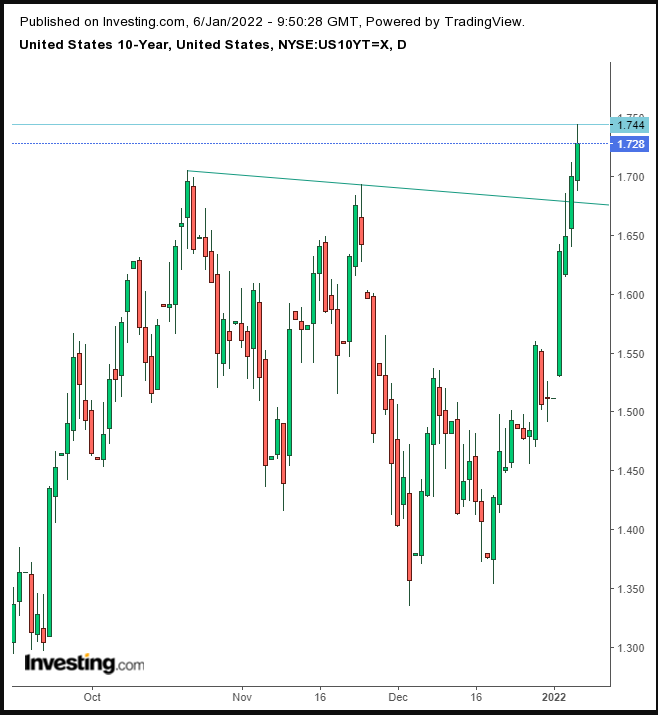
Rates provide an upside breakout of their downtrend line since the Oct. 21 high, suggesting a continued bond selloff. Treasuries were dumped along with stocks, as investors had to break their current positions, a rare event, since the two asset classes generally possess a negative divergence.
The dollar continues to meander. However, the expected tightening environment surrounding the greenback pushed the pound sterling down.
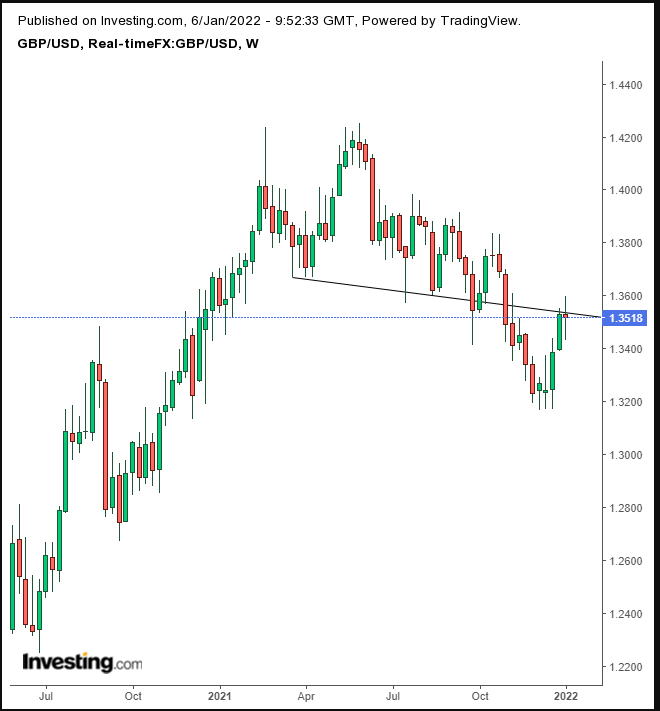
The reversal comes precisely at the neckline of a weekly H&S top.
Given that the euro is the most significant counter to the dollar in the Dollar Index, the USD is flat, as investors priced in a rate rise by the ECB.
The minutes from the FOMC meeting also pushed gold lower.
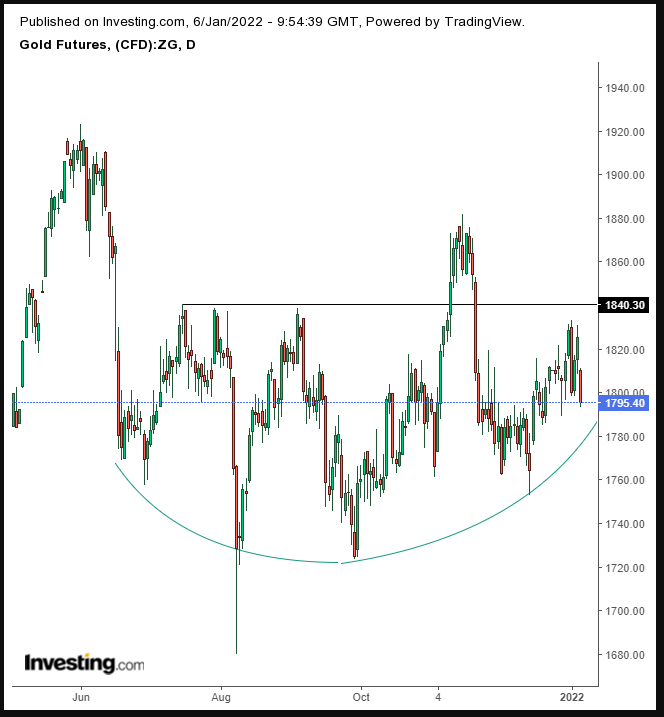
The price of the yellow metal is at its rounding bottom.
Bitcoin completed a massive H&S top whose implied target is aiming lower, toward $30,000. The $40,000 mark could be used as a filter.
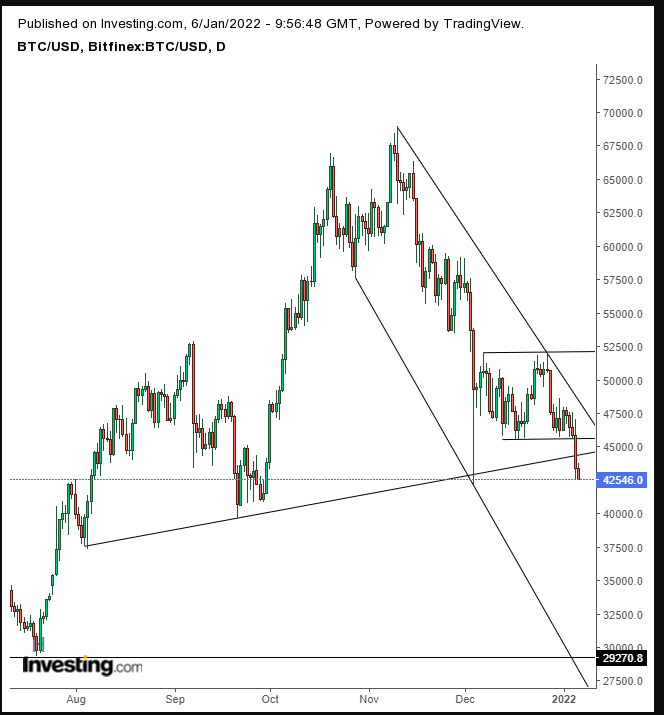
If the price falls below that level, the odds rise dramatically for a continued selloff.
Oil rebounded from an earlier selloff, rising for the fourth straight day, but it could still be trading within a bearish pattern.
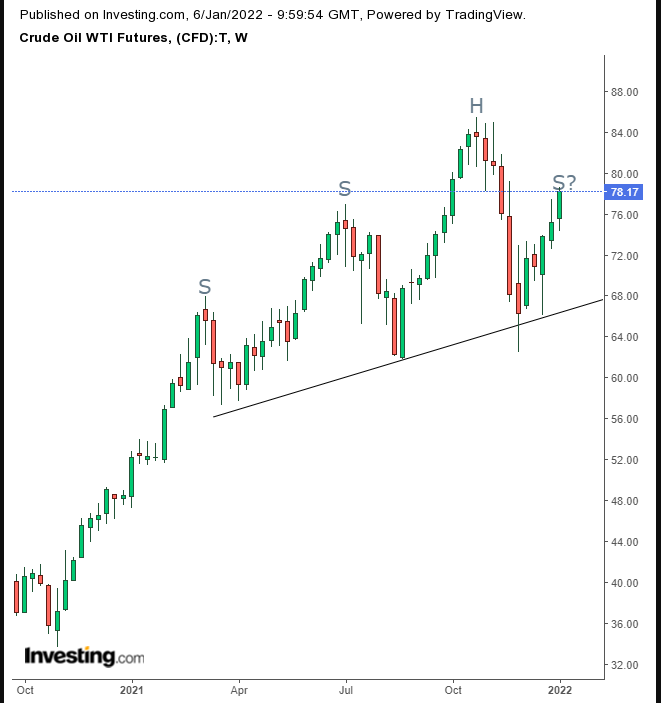
The price may be developing a top. During December 2021, the Federal Reserve Bank of Dallas forecast modestly higher prices for this year.
Up Ahead
- On Friday CPI figures for the Eurozone are published.
- US nonfarm payrolls are released on Friday.
- Canadian PMI figures are printed on Friday.
Market Moves
Stocks
- The STOXX 600 fell 1.1%
- Futures on the S&P 500 were little changed
- Futures on the NASDAQ 100 fell 0.2%
- Futures on the Dow Jones Industrial Average were little changed
- The MSCI Asia Pacific Index fell 1.4%
- The MSCI Emerging Markets Index fell 0.7%
Currencies
- The Dollar Index rose 0.1%
- The euro was little changed at $1.1307
- The Japanese yen fell 0.2% to 115.86 per dollar
- The offshore yuan rose 0.2% to 6.3859 per dollar
- The British pound fell 0.2% to $1.3523
Bonds
- The yield on 10-year Treasuries advanced two basis points to 1.72%
- Germany's 10-year yield rose two basis points to -0.06%
- Britain's 10-year yield increased four basis points to 1.13%
Commodities
- WTI crude rose 0.3% to $78.08
- Brent crude rose 0.2% to $80.94 a barrel
- Spot gold fell 0.9% to $1,794.32 an ounce
